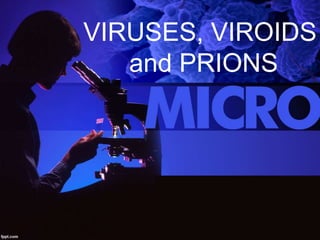
Virus, Viroids and Prions
- 2. VIRUS • Generally are quite small, 20-300 nm. • Obligate intracellular parasite. • Viruses can infect all types of life forms, from animals and plants to bacteria and archaea. • Viral Genome: DNA or RNA : ss or ds
- 3. VIRAL COMPONENTS • Contain only those parts needed to invade and control a host cell – External coating • Capsid - a protein coat which forms from individual molecules called capsomeres. • Envelope- in 13 of the 20 families of animal viruses • If no envelope, called naked virus – Core • DNA • RNA – The capsid and the nucleic acid together are called the nucleocapsid • Fully formed virus that is able to establish an infection in a host cell- virion
- 5. VIRAL COMPONENTS Ex. Polio virus Ex. Herpes simplex
- 6. Viral Classification according to morphology
- 7. Viral Classification according to symmetry
- 8. Modes of Viral Replication • Adsorption • Penetration • Uncoating • Synthesis • Assembly • Release
- 9. Adsorption • Virus encounters susceptible host cells • Adsorbs specifically to receptor sites on the cell membrane
- 10. Penetration & Uncoating • Flexible cell membrane of the host is penetrated by the whole • Endocytosis • Uncoating immediately follows: Enzymes in the vacuole dissolve the envelope and capsid
- 11. Synthesis • Free viral nucleic acid exerts control over the host’s synthetic and metabolic machinery • DNA viruses- enter host cell’s nucleus where they are replicated – DNA enters the nucleus and is transcribed into RNA – The RNA becomes a message for synthesizing viral proteins (translation) – New DNA is synthesized using host nucleotides
- 12. Assembly & Release • Assembly of enveloped viruses needs interaction with plasma membrane which has been modified • Final stage of infection • Enveloped viruses released gradually by budding or exocytpsis. • Naked viruses accumulate in cytoplasm and released during lysis
- 14. Damage to the Host Cell • Cytopathic effects- virus-induced damage to the cell that alters its microscopic appearance • Inclusion bodies- compacted masses of viruses or damaged cell organelles
- 16. Viruses that Infect Bacteria • Bacteriophage
- 18. Cycles of Viral Reproduction Provirus /Temperate virus
- 20. VIROIDS • Mostly plant pathogens • Consists solely of small single- stranded circular RNA molecule having 250-370 nucleotides long. • The RNA of a viriod doesn’t encode any gene products; so they can’t replicate themselves. • They adopt the host RNA Polymerase II which synthesizes a negative RNA strand. Then it serves as a template for the synthesis of the other viriod RNAs. • No protein coat.
- 22. Transmission • Viroid infections are transmitted by cross contamination following mechanical damage to plants as a result of horticultural or agricultural practices. • Some are transmitted by aphids and they can also be transferred from plant to plant by leaf contact.
- 23. DISEASES CAUSED BY VIRIODS • Viriods causes over 20 different plant diseases of which the most studied are – POTATO SPINDLE-TUBER DISEASE – CHRYSANTHEMUM STUNT DISEASE
- 24. Hepatitis D • Caused by Hepatitis delta virus(HDV). • HDV is enclosed in a Hepatitis B virus capsid • The HDV genome exists as an enveloped negative sense, single- stranded, closed circular RNA. • HDV is the smallest viriod known to infect animals.
- 25. Hepatitis D • Liver failure and rapid progression to liver cirrhosis. • In combination to HBV, HDV has the highest mortality rate of all hepatitis infections. • Enters the bloodstream and can be transmitted via blood or serum.
- 26. PRIONS • Prions are infectious agents composed primarily of sialoglycoprotein. • This protein is called prion protein (PrP) • They contain no nucleic acid. • They cause a variety of neurodegenerative diseases in humans and animals.
- 27. Normal prion Abnormal prion protein protein PrPc PrPSc
- 28. PATHOGENICITY • The most studied prion is scrapie prion that causes the scrapie disease in sheeps and goats. • Studies show that the causative agent, PrPSc, enters the brain of an animal converting the normal PrPc to PrPSc which continue this conversion chain by changing its folding patterns.
- 29. MODE OF TRANSMISSION • It has been recognized that prion diseases can arise in three different ways: 1. Acquired 2. Familial 3. Sporadic Current research suggests that the primary method of infection in animals is through ingestion.
- 30. DISEASES CAUSED BY PRIONS • In cattles • Bovine Spongiform Encephalopathy or Mad Cow Disease • In Humans • Alzheimer’s disease • Down’s syndrome • Fatal familial insomnia • Kuru Leprosy
- 32. Virus Viroids Prions Genome DNA or RNA RNA None Strand Ds or ss ss ss Coat Capsid and Envelope For HDV only None Target Animal, plant, bacteria, archea Plants Animals Host Cell / Organ All type of cells Plant cells Nervous sysem
- 33. References Baron, S. 2004. Structure and Classifications of Viruses. Medical Microbiology. 4th edition Houghton Mifflin Harcort. 2014. Viral Structure and Replication. Microbiology. Tortora, G., et.al. 2010. Microbiology: An Introduction. McGraw-Hill Companies
Editor's Notes
- Poliovirus, have RNA genomes and some, like herpesvirus, have DNA genomes. Influenza virus have single-stranded genomes, while others (like smallpox) have double-stranded genomes.
- Rotaviruses cause enteric disease with symptoms characterized by diarrhea, vomiting, abdominal discomfort, and fever, or any combination. The virus affects mainly infants and young children. Diarrhea ranges from mild to severe and can cause fatal dehydration.
